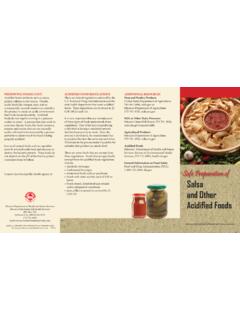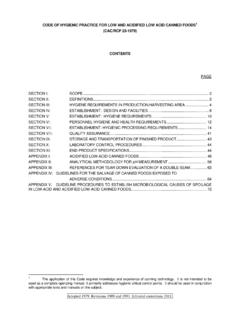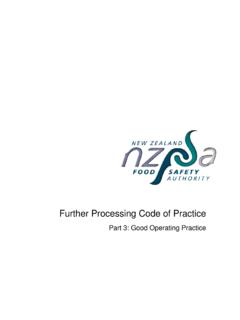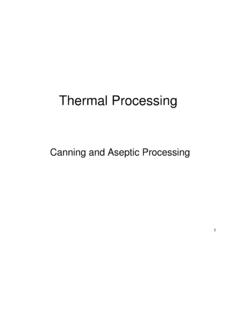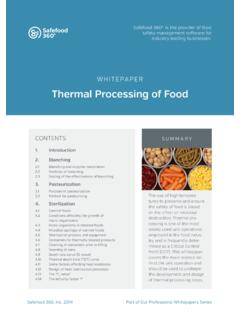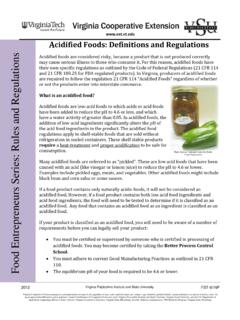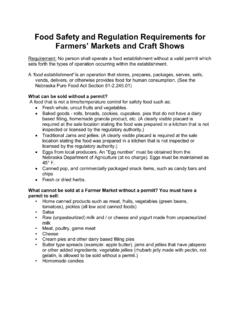Transcription of LOW ACID CANNED FOODS - National Fisheries Institute
1 21 CFR 113 1 NOTE: The following is an unofficial reprint of the regulation provided for reference only. Please refer to the Government Printing Office at for the most current and official version of the regulation. Title 21 of the Code of Federal Regulation Part 113 Thermally Processed Low acid FOODS Packaged in Hermetically Sealed Containers (Authority: 21 342, 371, 374; 42 264. Source: 44 FR 16215, Mar. 16, 1979, unless otherwise noted.) Subpart A General Provisions Definitions. For the purposes of this part, the following definitions apply: (a) Aseptic processing and packaging means the filling of a commercially sterilized cooled product into pre sterilized containers, followed by aseptic hermetical sealing, with a presterilized closure, in an atmosphere free of microorganisms.
2 (b) Bleeders means openings used to remove air that enters with steam from retorts and steam chambers and to promote circulation of steam in such retorts and steam chambers. Bleeders may serve as a means of removing condensate. (c) Come up time means the time which elapses between the introduction of steam into the closed retort and the time when the retort reaches the required processing temperature. (d) Commercial processor includes any person engaged in commercial, custom, or institutional (church, school, penal, or other organization) processing of food , including pet food . Persons engaged in the production of FOODS that are to be used in market or consumer tests are also included. (e) Commercial sterility: (1) Commercial sterility of thermally processed food means the condition achieved (i) By the application of heat which renders the food free of (a) Microorganisms capable of reproducing in the food under normal nonrefrigerated conditions of storage and distribution; and LOW acid CANNED FOODS 21 CFR 113 2 (b) Viable microorganisms (including spores) of public health significance; or (ii) By the control of water activity and the application of heat, which renders the food free of microorganisms capable of reproducing in the food under normal nonrefrigerated conditions of storage and distribution.
3 (2) Commercial sterility of equipment and containers used for aseptic processing and packaging of food means the condition achieved by application of heat, chemical sterilant(s), or other appropriate treatment that renders the equipment and containers free of viable microorganisms having public health significance, as well as microorganisms of nonhealth significance, capable of reproducing in the food under normal nonrefrigerated conditions of storage and distribution. (f) Critical factor means any property, characteristic, condition, aspect, or other parameter, variation of which may affect the scheduled process and the attainment of commercial sterility. (g) Flame sterilizer means an apparatus in which hermetically sealed containers are agitated at atmospheric pressure, by either continuous, discontinuous, or reciprocating movement, with impinging gas flames to achieve sterilization temperatures.
4 A holding period in a heated section may follow the initial heating period. (h) Headspace, gross is the vertical distance between the level of the product (generally the liquid surface) in an upright rigid container and the top edge of the container (the top of the double seam of a can or the top edge of a glass jar). (i) Headspace, net of a container is the vertical distance between the level of the product (generally the liquid surface) in the upright rigid container and the inside surface of the lid. (j) Hermetically sealed container means a container that is designed and intended to be secure against the entry of microorganisms and thereby to maintain the commercial sterility of its contents after processing. (k) Incubation means the holding of a sample(s) at a specified temperature for a specified period of time for the purpose of permitting or stimulating the growth of microorganisms.
5 (l) Initial temperature means the average temperature of the contents of the coldest container to be processed at the time the thermal processing cycle begins, as determined after thorough stirring or shaking of the filled and sealed container. (m) Lot means that amount of a product produced during a period of time indicated by a specific code. (n) Low acid FOODS means any FOODS , other than alcoholic beverages, with a finished equilibrium pH greater than and a water activity (aw) greater than Tomatoes and tomato products having a finished equilibrium pH less than are not classed as low acid FOODS . (o) Minimum thermal process means the application of heat to food , either before or after sealing in a hermetically sealed container, for a period of time and at a temperature scientifically determined to be adequate to ensure destruction of microorganisms of public health significance.
6 (p) Operating process means the process selected by the processor that equals or exceeds the minimum requirements set forth in the scheduled process. 21 CFR 113 3 (q) Retort means any closed vessel or other equipment used for the thermal processing of FOODS . (r) Scheduled process means the process selected by the processor as adequate under the conditions of manufacture for a given product to achieve commercial sterility. This process may be in excess of that necessary to ensure destruction of microorganisms of public health significance, and shall be at least equivalent to the process established by a competent processing authority to achieve commercial sterility. (s) Shall is used to state mandatory requirements. (t) Should is used to state recommended or advisory procedures or to identify recommended equipment.
7 (u) Vacuum packed products means those products that are sealed in a container under the vacuum specified in the scheduled process, the maintenance of which vacuum is critical to the adequacy of the scheduled process. (v) Vents means openings through the retort shell, controlled by gate, plug cock, or other adequate valves used for the elimination of air during the venting period. (w) Water activity (aw) is a measure of the free moisture in a product and is the quotient of the water vapor pressure of the substance divided by the vapor pressure of pure water at the same temperature. Current good manufacturing practice. The criteria in , , , , , , , and shall apply in determining whether the facilities, methods, practices, and controls used by the commercial processor in the manufacture, processing, or packing of low acid FOODS in hermetically sealed containers are operated or administered in a manner adequate to protect the public health.
8 Personnel. The operators of processing systems, retorts, aseptic processing and packaging systems and product formulating systems (including systems wherein water activity is used in conjunction with thermal processing) and container closure inspectors shall be under the operating supervision of a person who has attended a school approved by the Commissioner for giving instruction appropriate to the preservation technology involved and who has been identified by that school as having satisfactorily completed the prescribed course of instruction. This person shall supervise only in those areas for which a school approved by the Commissioner identifies the person as having satisfactorily completed training. Subpart B [Reserved] Subpart C Equipment Equipment and procedures.
9 (a) Equipment and procedures for pressure processing in steam in still retorts (1) Temperature indicating device. Each retort shall be equipped with at least one temperature indicating device that accurately indicates the temperature during processing. Each temperature indicating device shall have a sensor and a display. Each temperature indicating device and each 21 CFR 113 4 reference device that is maintained by the processor shall be tested for accuracy against a reference device for which the accuracy is traceable to a National Institute of Standards and Technology (NIST), or other National metrology Institute , standard reference device by appropriate standard procedures, upon installation and at least once a year thereafter, or more frequently if necessary, to ensure accuracy during processing.
10 Each temperature indicating device and each reference device that is maintained by the processor shall have a tag, seal, or other means of identity. (i) The design of the temperature indicating device shall ensure that the accuracy of the device is not affected by electromagnetic interference and environmental conditions. (ii) Records of the accuracy of the temperature indicating device and of a reference device that is maintained by the processor shall be established and maintained in accordance with (c) and (d). (iii) A temperature indicating device that is defective or cannot be adjusted to the accurate calibrated reference device shall be repaired before further use or replaced. (iv) A temperature indicating device shall be accurate to 1 F ( C).
